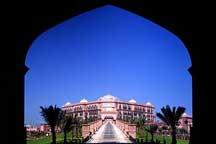Laibin (Guangxi) City Information
2009-12-28 09:59 BJT
Introduction
 |
Laibin is located in the middle of Guangxi Zhuang Autonomous Region. It covers an area of 13,449 sq km. Its population is 2.3 million.
Laibin has a subtropical monsoon climate with plenty of sunshine and rain. The average temperature is 18.9 Celsius, while the average annual precipitation is 900-1230 mm.
Laibin is rich in natural resources. Forests cover 43.4% of the city's lands. Mineral resources such as barite and coal are abundant. Laibin's exports of barite have ranked first in Guangxi for many consecutive years. Jinxiu Yao Autonomous County, under the administration of Laibin, is a town known for aniseed and for the largest water conservation forest reserve in the autonomous region.
Transportation in Laibin is very convenient and mainly relies on highways, railways and waterways. The city is 60km from Liuzhou and 156km from Nanning. The Guangxi-Hunan Railway and the Guilin-Beihai Expressway run through the city. In addition, 500-800 ton ships are able to sail down the Hongshui River directly to Guangzhou, Hong Kong and Macau.
Economic Features
Laibin realized GDP of RMB 24.4 billion in 2007, a rise of 15.3% year on year. The city's GDP accounted for approximately 4.1% of Guangxi's total, and ranked 11th in the autonomous region.
The agricultural sector generated value-added output of RMB 8.2 billion in 2007, accounting for 33.8% of the city's GDP. Secondary industry (industry and construction), the largest contributor to the city's economic, realized value-added output of RMB 9.6 billion, accounting for 39.6% of the city's total.
In 2007, the city's industry sector realized value-added industrial output of RMB 8.8 billion, up 23.7% year on year. Sugar production, electricity power, ferroalloy smelting, non-metallic mining and coal are the pillar industries of the city. In 2007, they realized value-added industrial output of RMB 1.6 billion, RMB 2.8 billion, RMB 731 million, RMB 123 million and RMB 121 million, up 74.5%, 8.8%, 36.8%, 3.3% and decreasing 10.4% year on year, respectively. Their total value-added industrial output contributed 61% to the city's industrial sector.
The service sector contributed 26.6% of the city's total GDP in 2007. During 2007, 2.5 million tourists visited the city, 13.7% more than in the previous year, and tourism income totaled RMB 914 million, increasing 19.1% compared to the previous year.
In 2007, the total value of imports and exports amounted to US$241 million (comprising export value of US$132 million and import value of US$109 million), up 60.4% year on year. The city's major export goods are ferroalloy, barite, manganese, and zinc oxide. Exports sell primarily to countries in the Association of South East Asian Nations (ASEAN).
In 2007, the utilized FDI of the city was US$20.4 million, representing a huge increment of 1040% year on year.

 Mail
Mail Share
Share Print
Print


 Video
Video









 2009 China Central Television. All Rights Reserved
2009 China Central Television. All Rights Reserved